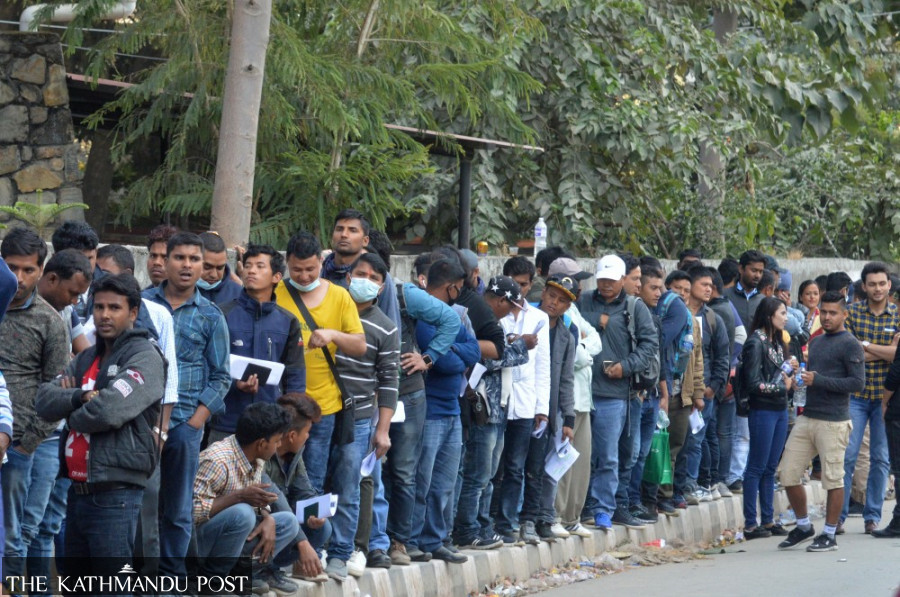Money
Nepali migrant workers sent home record Rs1.22 trillion
Remittance income swelled by 21.2 percent in the last fiscal year, according to Nepal Rastra Bank.
Post Report
Nepali migrant workers sent home Rs1.22 trillion in the last fiscal year ended mid-July, a record-high money transfer to Nepal, the central bank said in its macroeconomic report.
According to Nepal Rastra Bank, remittance income swelled by 21.2 percent in the last fiscal year compared to an increase of 4.8 percent in the previous year.
In United States dollar terms, remittance inflows rose by 12.1 percent to $9.33 billion in the review year.
The number of Nepali workers obtaining approval for foreign employment reached 774,976 in the last fiscal year. Among them, 277,272 are renewed entry.
A steep jump in tourist arrivals helped Nepal’s foreign exchange reserve to increase. Remittance and tourist spending are two major foreign exchange sources for the country.
Tourist arrivals increased significantly to 862,992 in the last fiscal year 2022-23 from 374,147 in the previous fiscal year.
The income from tourists increased 89.6 percent to Rs61.52 billion in the review year, compared to Rs32.45 billion in the previous year, the central bank said.
Despite the rise in tourist numbers, net services income in 2022-23 showed a deficit of Rs83.85 billion. This means more Nepalis travelled abroad than foreign tourists came to Nepal.
The central bank said that Nepalis spent Rs144.46 billion on foreign travel, including Rs100.42 billion for education in the review year.
The country’s balance of payments remained at a surplus of Rs290.52 billion in the review year against a deficit of Rs255.26 billion in the previous year.
In US dollar terms, the balance of payments remained at a surplus of $2.21 billion in the review year compared to a deficit of $2.15 billion in the previous year.
Nepal’s gross foreign exchange reserves increased 26.6 percent to Rs1.53 trillion in mid-July 2023 from Rs1.21 trillion in mid-July 2022.
The central bank report said that the fiscal position of the government, based on banking transactions, remained at a deficit of Rs486.89 billion in the last fiscal year compared to a deficit of Rs263.67 billion in the previous fiscal year.
The total expenditure of the government, according to the Financial Comptroller General Office, amounted to Rs1.42 trillion in 2022-23 compared to Rs1.29 trillion in the previous fiscal year.
The recurrent, capital and financing expenditures of the federal government amounted to Rs1 trillion, Rs233.70 billion and Rs190.11 billion respectively in the last fiscal year.
Revenue collection (including the amount to be transferred to provincial and local governments) stood at Rs957.15 billion in the last fiscal year.
Total government revenue was Rs1.06 trillion in the previous fiscal year. The total resource mobilisation (including revenue and other receipts) of the government stood at Rs1.01 trillion in 2022-23.
The central bank said that during 2022-23, merchandise exports decreased 21.4 percent to Rs157.14 billion against an increase of 41.7 percent in the previous year. Destination-wise, exports to India fell by 31.3 percent, while exports to China and other countries increased by 118.3 percent and 10.7 percent respectively.
Exports of zinc sheet, particle board, cardamom, woollen carpet, polyester yarn and thread, among others, increased while exports of soybean oil, palm oil, oil cake, textile, silverware and jewellery, among others, decreased in the review period.
In the review year, merchandise imports shrank by 16.1 percent to Rs1.61 trillion.
Destination-wise, imports from India, China and other countries decreased by 14.4 percent, 15.9 percent and 20.7 percent respectively.
Imports of sponge iron, chemical fertiliser, other stationeries, bitumen and paper, among others, increased whereas imports of transport equipment and parts, MS billet, medicine, petroleum products, and crude soybean oil, among others, decreased in the review year.
The total trade deficit decreased 15.5 percent to Rs1.45 trillion in the review year. The deficit had increased by 23.0 percent in the previous year.
The central bank said that the annual average consumer price inflation stood at 7.74 percent in the last fiscal year compared to 6.32 percent in the previous fiscal year.
Under the food and beverage category, the annual average consumer price index of the restaurant and hotel sub-category increased by 14.42 percent, spices by 12.50 percent, cereal grains and their products by 10.70 percent, tobacco products by 9.88 percent, and milk products and eggs by 9.23 percent.
Likewise, under the non-food and services category, the annual average consumer price index of the transportation sub-category increased by 13.50 percent, recreation and culture by 10.18 percent, health by 10.01 percent, education by 8.79 percent and housing and utilities by 8.65 percent.
The National Statistics Office has estimated economic growth at producers’ prices to be 1.86 percent for 2022-23. The agriculture, industry and service sectors are estimated to grow 2.73 percent, 0.59 percent and 2.33 percent respectively.
The share of the agriculture, industry and service sectors in GDP stands at 24.12 percent, 13.45 percent and 62.43 percent respectively in 2022-23.
The central bank said that the installed capacity of electricity increased to 2,684.4 megawatts in the last fiscal year, which consists of 2,537.9 megawatts of hydroelectricity, 87 megawatts of solar, 6 megawatts of cogeneration and 53.4 megawatts of thermal electricity.




 5.4°C Kathmandu
5.4°C Kathmandu












%20(1).jpg&w=300&height=200)
